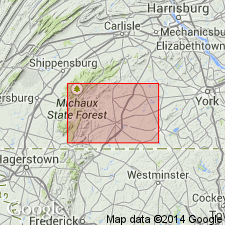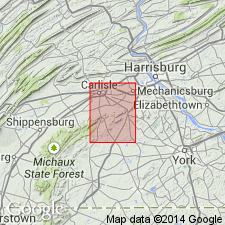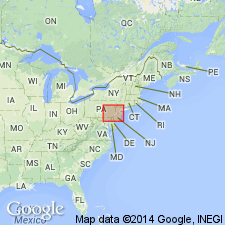
- Usage in publication:
-
- Heidlersburg member*
- Modifications:
-
- Named
- Dominant lithology:
-
- Shale
- Sandstone
- AAPG geologic province:
-
- Piedmont-Blue Ridge province
- Gettysburg basin
Summary:
Beds near the middle of the Gettysburg shale in Adams Co. are here named the Heidlersburg member. It is composed of red shale and sandstone with green gray, and black shales, interbedded with harder gray to white sandstone. Composite section is 4,800 ft thick. Age is Late Triassic.
Source: GNU records (USGS DDS-6; Reston GNULEX).

- Usage in publication:
-
- Heidlersburg sandstone member*
- Modifications:
-
- Revised
- Redescribed
- AAPG geologic province:
-
- Piedmont-Blue Ridge province
- Gettysburg basin
Summary:
The Heidlersburg sandstone member in the lower part of the Gettysburg shale consists of hard, light-colored sandstone that forms a ridge in the SE part of the Carlisle quad., Adams and York Cos., PA.
Source: GNU records (USGS DDS-6; Reston GNULEX).

- Usage in publication:
-
- Heidlersburg Member
- Modifications:
-
- Overview
- AAPG geologic province:
-
- Piedmont-Blue Ridge province
- Gettysburg basin
Summary:
The geographic and stratigraphic positions of the Lockatong Formation and Heidlersburg Member of the Gettysburg Formation and their similar dark, fine-grained lithologies suggest that they represent rocks deposited in an environment of low mechanical energy near the basin centers, and that they may be homotaxial.
Source: GNU records (USGS DDS-6; Reston GNULEX).
For more information, please contact Nancy Stamm, Geologic Names Committee Secretary.
Asterisk (*) indicates published by U.S. Geological Survey authors.
"No current usage" (†) implies that a name has been abandoned or has fallen into disuse. Former usage and, if known, replacement name given in parentheses ( ).
Slash (/) indicates name conflicts with nomenclatural guidelines (CSN, 1933; ACSN, 1961, 1970; NACSN, 1983, 2005, 2021). May be explained within brackets ([ ]).

